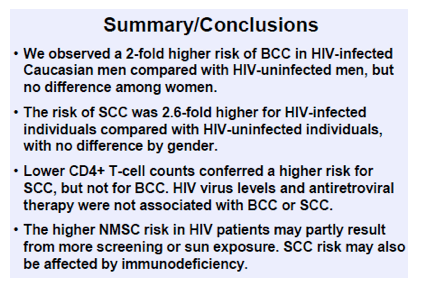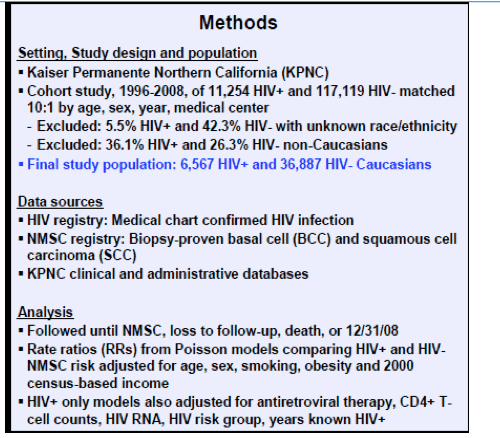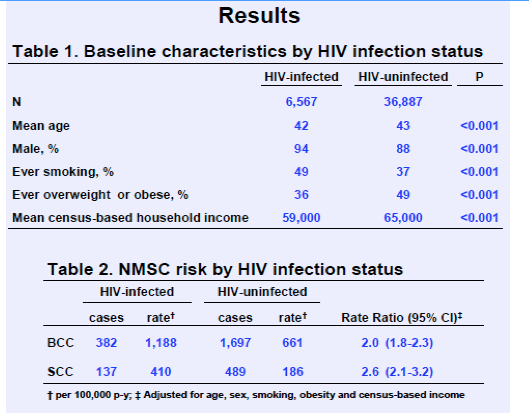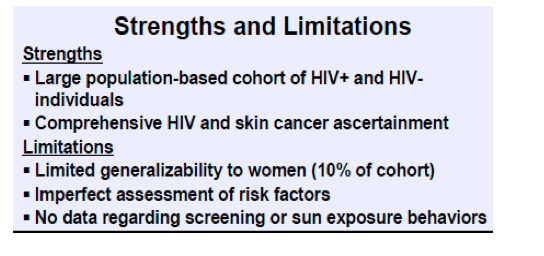 |
 |
 |
| |
Skin Cancer in HIV: Doubled Rate of Nonmelanoma Skin Cancer With HIV in California Comparison
|
| |
| |
6th IAS Conference on HIV Pathogenesis, Treatment and Prevention, July 17-20, 2011, Rome
Mark Mascolini
HIV-positive Caucasians cared for in northern California's Kaiser Permanente healthcare system had a twice higher risk of nonmelanoma skin cancers than white HIV-negative Kaiser patients [1]. A lower recent CD4 count boosted the risk of small-cell carcinoma.
Because nonmelanoma skin cancers usually do not get recorded in cancer registries, little is known about their prevalence or incidence in people with HIV. To address those questions, Kaiser investigators planned this comparison of HIV-positive and negative people in their large healthcare system. The Kaiser team matched 6567 HIV-positive people to 36,887 HIV-negative people by age, gender, year, and medical center. The analysis excluded nonwhites and people without known race or ethnicity. Follow-up continued until a person had biopsy-proved basal cell carcinoma or squamous cell carcinoma or until loss to follow-up, death, or the end of 2008.
The HIV group was slightly but significantly younger (42 versus 43) and had a higher proportion of people who ever smoked (49% versus 37%), a lower proportion of people ever overweight or obese (36% versus 49%), and a lower census-based household income ($59,000 versus $65,000) (P < 0.001 for all comparisons).
For each of the nonmelanoma skin cancers, rates per 100,000 person-years were much higher in people with HIV, regardless of CD4 count, than in the HIV-negative comparison group:
Basal cell carcinoma:
HIV-negative: 661 cases per 100,000 person-years
HIV-positive 500 or more CD4s: 1035 cases per 100,000 person-years
HIV-positive 201 to 499 CD4s: 1263 cases per 100,000 person-years
HIV-positive 200 or fewer CD4s: 1327 cases per 100,000 person-years
Squamous cell carcinoma:
HIV-negative: 186 cases per 100,000 person-years
HIV-positive 500 or more CD4s: 266 cases per 100,000 person-years
HIV-positive 201 to 499 CD4s: 445 cases per 100,000 person-years
HIV-positive 200 or fewer CD4s: 649 cases per 100,000 person-years
A statistical model comparing nonmelanoma skin cancer rates in the HIV-positive and negative groups considered age, gender, smoking, obesity, and 2000 census-based income. This comparison showed that the HIV group had a doubled risk of basal cell carcinoma and a 2.6 times higher risk of squamous cell carcinoma:
Basal cell carcinoma:
HIV-positive versus negative: 1188 versus 661 cases per 100,000 person-years, rate ratio (RR) 2.0, 95% confidence interval (CI) 1.8 to 2.3
Squamous cell carcinoma:
HIV-positive versus negative: 410 versus 186 cases per 100,000 person years, RR 2.6, 95% CI
2.1 to 3.2
A model analyzing risk factors in the HIV group considered age, current and baseline CD4 count, current viral load, HIV transmission risk group, years with HIV infection, antiretroviral therapy use, smoking, obesity, and census-based income. Compared with the HIV-negative group, men had a twice higher risk of basal cell carcinoma (RR 2.1, 95% CI 1.8 to 2.3, P < 0.001) and more than a doubled risk of squamous cell carcinoma (RR 2.6, 95% CI 2.1 to 2.3, P < 0.001). Women had almost a tripled risk of squamous cell carcinoma compared with the HIV-negative group (RR 2.7, 95% CI 1.0 to 8.0, nonsignificant at P = 0.063) but not a higher risk of basal cell carcinoma. Basal cell carcinoma risk was significantly higher in HIV-positive men than HIV-positive women (P = 0.041).
Compared with a CD4 count at or above 500, a recent CD4 count of 200 or under almost tripled the risk of squamous cell carcinoma (adjusted rate ratio 2.7 , 95% CI 1.4 to 5.2) and a recent count of 201 to 499 almost doubled the risk (adjusted rate ratio 1.7, 95% CI 1.0 to 2.7). A basal- to squamous-cell carcinoma comparison showed differences in rates of these nonmelanoma cancers by HIV status and current CD4 count. For HIV-negative Kaiser patients, the basal-to-squamous ratio was 3.5-to 1, for HIV-positive people with 500 or more CD4s the ratio was 3.7-to-1, for HIV-positive people with 201 to 499 CD4s the ratio was 2.7-to-1, and for HIV-positive people with 200 or fewer CD4s the ratio was 2.0-to-1.
The Kaiser-Permanente team noted that women represented only 10% of the cohort, that risk factor assessment was limited, and that they had no data on cancer screening or sun exposure in the study population. On the plus side, the analysis considered large populations of HIV-positive and negative people who had comprehensive HIV and skin cancer ascertainment.
The investigators suggested that higher risk of both nonmelanoma cancers in people with HIV may reflect more intense cancer screening of the HIV group or their greater sun exposure. The higher squamous cell carcinoma risk in people with HIV, they added, may partly reflect their immunodeficiency. The Kaiser team noted that viral load and antiretroviral therapy had no measurable impact on risk of these two nonmelanoma skin cancers.
Reference
1. Silverberg M, Leyden W, Warton M, Engels E, Asgari M. HIV infection and non-melanoma skin cancer risk. 6th IAS Conference on HIV Pathogenesis, Treatment and Prevention. July 17-20, 2011. Rome. Abstract TUPE235.
------------------------------------------
HIV infection and non-melanoma skin cancer risk
Reported by Jules Levin
Michael J. Silverberg1, Wendy Leyden1, E. Margaret Warton1, Eric A. Engels2, Maryam Asgari1
1 Division of Research, Kaiser Permanente Northern California, Oakland, CA; 2 Division of Cancer Epidemiology and Genetics, National Cancer Institute, Rockville, MD

Background and Significance
HIV patients have a higher risk of cancer, particularly those with known viral etiology such as Kaposi sarcoma and anal cancer
Unknown whether non-melanoma skin cancers (NMSCs) are also increased since not typically recorded in cancer registries
Objectives
To compare NMSC incidence by HIV infection status
To study effect of HIV immunodeficiency on NMSC incidence




|
| |
|
 |
 |
|
|